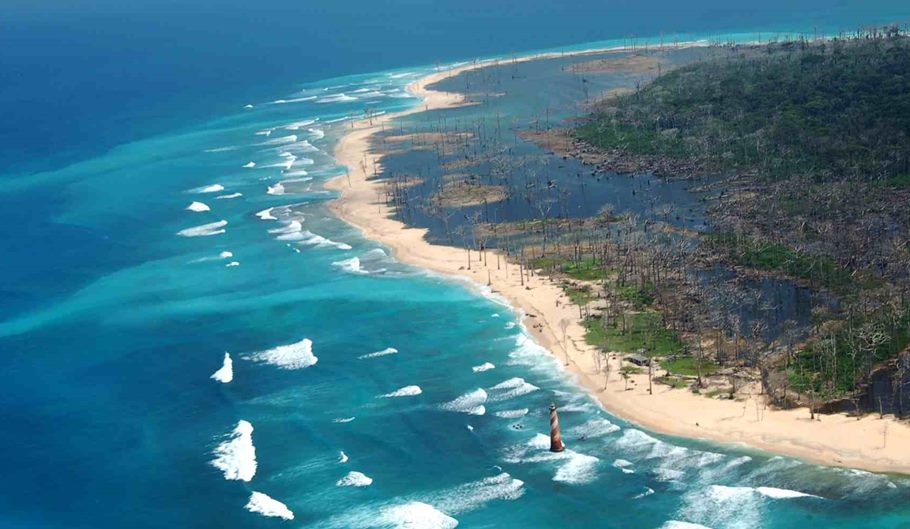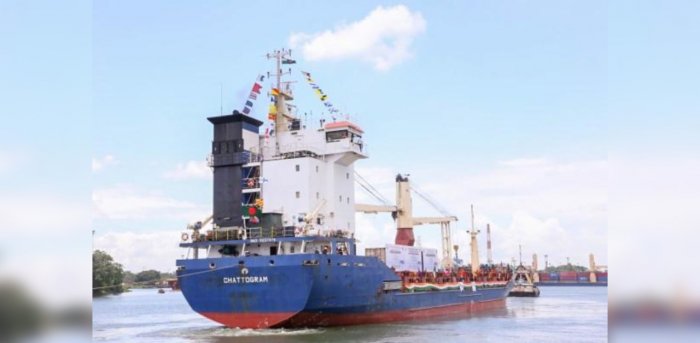For developing A&N Islands, the focus should be on strengthening the ailing infrastructure, especially shipping and then perhaps develop the Port Blair harbour to handle the trans-shipment needs of domestic market.
By Dr Punam Tripathi
While inaugurating the much awaited undersea optical fibre project to provide high-speed internet to Andaman and Nicobar Islands, PM Narendra Modi announced the next big project for the islands – construction of a Transhipment Port at Great Nicobar Island at an estimated cost of Rs. 10,000 crores (Rupees 100 Billion).
Great Nicobar Island, where the proposed port is to come up, is the southernmost island of the archipelago of Andaman and Nicobar. It is the largest island of the Nicobar archipelago with a coastline of 202 kilometres and an area of 921 square kilometres. The Island also has six perennial rivers and an equatorial climate with year round high temperatures and heavy rainfall.

Large part of Great Nicobar Island was designated as Biosphere Reserve by Govt of India in 1981. Within it lie two national parks – the Campbell Bay National Park and Galathea National Park, both gazetted in 1992. Because of its mega diversity and high endemism, the reserve was included in the UNESCO Man and Biosphere program in May 2013.
Parts of the Great Nicobar Island are inhabited by the Nicobarese and Shompen. The latter are the indigenous people who inhabited the interior while the former occupied the coasts of Great Nicobar Island. Post-Independence, one among the four resettlement schemes was in the Great Nicobar Islands. Between 1969 and 1975, a total of 330 ex-servicemen families, one-third from Punjab, were resettled in an area around Campbell Bay on the east coast, which was cleared and the families settled in six villages.
The Government now plans to invest Rs. 10,000 crores for the transhipment Port at Great Nicobar Island.
It’s obvious that the existing transhipment ports on mainland India haven’t achieved what they intended as India’s port infrastructure is poor. Almost all the major ports in India lack deep drafts which has become essential requirement because the size of the vessels around the world is increasing day by day.

Another serious problem with foreign transhipment ports India uses is the control of China. Colombo Port at Sri Lanka handles over 40 percent of India’s transhipment is run by China. In the present geo-political scenario, this can lead to difficult consequences for India.
To address this need, transhipment port was constructed at Vallarpadam (Kochi, Kerala) and began operations in February 2011. Two more transhipment ports are under various stages of construction – Vizhinjam, Thiruvananthapuram and Enayam Kanyakumari.
A fourth transhipment port has been proposed at the Great Nicobar Island, A&N Islands.
The biggest advantage that Great Nicobar Island has is its strategic location. Indira Point is just 100 nautical miles (185.2 km) from Sumatra and 200 nautical miles (370.4 km) from Singapore. Second advantage is that the bays have deep natural water depths, a draft of 20 metres that can accommodate the latest generation of container vessels.
Moreover, it has been projected that transhipment port at Great Nicobar will primarily have three benefits. First, as it would enable mega-ships to anchor, this will raise India’s share in maritime trade as well as create new job opportunities.
Second, it will provide an alternative to transhipment ports at Colombo, Singapore and Klang (Malaysia).

Third, it will help in increasing India’s share in the global transhipment business as it is expected to draw the business of countries currently using other regional transhipment facilities such as Bangladesh and Myanmar, which are using facilities at Singapore.
However, these are just projections. What is the reality?
Will a Transhipment Port at Great Nicobar Island succeed? What are the costs involved? Is the project worth it? Transhipment Port at Great Nicobar Island is a perilous proposition primarily for various reasons.
The plan is based on projections and not on actual need. The Transhipment Port at Vallarpadam (Kerala) has not been able to draw business away from the Colombo Port. One primary reason is that charges at Indian transhipment ports are far higher than those at Colombo, and bureaucratic procedures at the latter are far smoother. The bureaucratic procedure in India will not change with the setting up of the transhipment port. In fact, the bureaucracy in the Islands is far more oppressive than on the mainland.
The bureaucratic procedure in India will not change with the setting up of the transhipment port. In fact, the bureaucracy in the Islands is far more oppressive than on the mainland.
Second, the transhipment ports around the region that have become successful had a great advantage which Great Nicobar Island lacks. These places were already peopled. It had a thriving population which provided the economies of scale for the development.
The South Bay of Great Nicobar Island does not have any population. The 70 years’ experience of resettlement in the Islands has been bitter. It has been established here time and again that creating an economy from scratch has resulted in a failure and has compounded the problem.
Third, the proposal declares that it will create job opportunities. But one must ask – for whom? The labour force has always been “imported” from the mainland for any construction work that has been carried out in this island.
Fourth, the “import” of labour from mainland India has given rise to illegal immigrants from nearby countries who come here and then settles here. The actual population of these islands may be far higher than given by the official documents. This puts pressure on the already fragile ecology of the islands.
Fifth, the indigenous tribal population of this island have been marginalized and suffered immensely in the 2004 South-Asia Tsunami. They will be marginalized further and their survival will be threatened if a transhipment port is constructed.
The sixth most important reason that makes this project perilous is that it can lead to ecological disaster. The Great Nicobar Island is ecologically sensitive. It is an incredible biodiversity hotspot, bestowed with a variety of ecosystems ranging from grasslands, evergreen forests, mangroves, deciduous trees and coral reefs. It is, in fact, part of the Sundaland biodiversity hotspot, one of the four hotspots that India houses.
In December 2017, the Zoological Survey of India published the first comprehensive account of the biological wealth of this island. As per this report there are 1767 species of fauna including both terrestrial and marine species. Many species are endemic and some new species were also recorded.
The island is also amongst the best sites for nesting turtles, especially for leatherbacks, green turtles and hawksbills. Several endemic species find a place on the IUCN Red List – the Nicobar flying fox is categorised ‘Vulnerable’, and the Nicobar tree shrew, Miller’s Nicobar rat and Nicobar megapode are listed as ‘Endangered’. A transhipment port will threaten and endanger this rich, unique but already dwindling biodiversity.
One can definitely agree that a Transhipment Port at Great Nicobar Island offers several advantages. But, is the cost involved viable?
The loss of rainforest, the loss of biodiversity, the loss of habitat cannot be compensated or replicated. Are we willing to trade something precious and invaluable with Rs.100 billion?
A recent news item in The Daily Telegrams declared that Madhya Pradesh has agreed for ‘compensatory afforestation’ against the deforestation that will take place in order to ‘develop’ the islands.
The administrators fail to comprehend that the equatorial rainforests of A&N Islands did not develop overnight. It has taken millennia to reach where it is. It has nurtured thousands of species of flora and fauna. It simply cannot be ‘compensated’. A transhipment port can be built anywhere along the 5422.6 km long coastline of mainland India, but a loss of rainforest and its biodiversity cannot be compensated by any part of the country.
Moreover, the advantages listed are based on projections. One must not forget that Sri Lanka, Singapore and Malaysia will not be a silent observer. They will give tough competition to this transhipment port, and these ports already have advantages that Great Nicobar lacks.
The Administration was governed with a protectionist approach since independence in order to preserve its natural and anthropological rarities against exploitative enticements. However, it seems that with the change of government, the policies too have changed.
Second, the port will be unsuitable for Indian market too. The logistics will not change much for domestic shipping as port handling charges will be required in shipping cargo back and forth to mainland India. Isn’t it wiser to develop a transhipment port at mainland India?
The development of a transhipment port has been proposed on several occasions since the 1980s, little progress could be made due to objections from the Ministry of Environment and Forest against large scale developments in these areas.
The Administration was governed with a protectionist approach since independence in order to preserve its natural and anthropological rarities against exploitative enticements. However, it seems that with the change of government, the policies too have changed.
The ill-conceived plans are a result of mainland dominance in the A&N Island Administration.
The proposal to develop transshipment port at Great Nicobar Island for the islanders is extractive, exploitative, abusive, manipulative and insensitive to the needs of the islanders.
On this transhipment project, the NITI Aayog says “the development process is being kept inclusive, drawing input from the UT administration as well as from the central government where required”. The point to note is that both the UT Administration (A&N Administration) and the central government is headed by the mainlanders who are not aware of the uniqueness of these islands.
The proposal to develop transhipment port at Great Nicobar Island for the islanders is extractive, exploitative, abusive, manipulative and insensitive to the needs of the islanders.
The point to note is that both the UT Administration (A&N Administration) and the central government is headed by the mainlanders who are not aware of the uniqueness of these islands.
In fact, for developing A&N Islands, first the focus should be on strengthening the ailing infrastructure, especially shipping infrastructure and then perhaps develop the Port Blair harbour to handle the transhipment needs of domestic market. To cater to the international market, transhipment ports can be developed anywhere on the 5400 km long coastline of mainland India.
Why compromise the pristine, invaluable and irreplaceable Great Nicobar Island for it?
Transhipment port project is good for Great Nicobar island but this project is not good for the species and the local inhabitants. Government invest 10,000cr for this transhipment port project but this amount make a huge benefits for our extinct species and the local inhabitants.